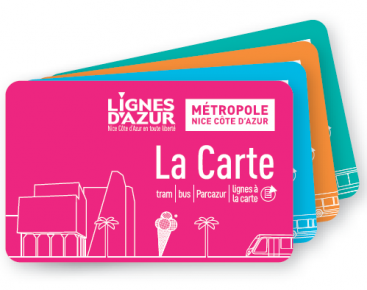The steep cliffs of the Côte d’Azur may endow this popular region of France with its unique and breathtaking beauty, but it also makes travel by car logistically challenging. If you’re staying in Nice or the surrounding areas for a fabulous French Riviera holiday, the fastest, cheapest, and most convenient way to get around is by public transportation.
Following is a detailed guide I have put together to help you navigate your car-free options. This is a fairly long article with lots of information, so I’ve created anchor links below in case you want to skip ahead to the sections that interest you most.
Public Transportation Landscape
Trip-Planning Tips
Taking The Train
Nice’s Trams and Buses
Local and Regional Buses
Getting to and from Nice Airport
Discount Passes
Public Transportation Landscape
Before I get into the nitty-gritty, here are some of the transportation names and acronyms you’ll encounter on your visit to the French Riviera.
SNCF: The Société Nationale des Chemins de Fer Françaisis France’s national railway company. It operates both freight and passenger service throughout France, including high-speed, long-distance, intercity, and regional trains.
SNCF Connect: This is the international ticketing agency operated by SNCF. The SNCF Connect app is the best and easiest way in my opinion to purchase train tickets in France. If you’re planning a trip, I would download it before you leave.
TER: Trains Express Régional is one of 18 regional rail networks operated by SNCF in partnership with regional governments. It is a specific category or brand of service, much like the Northeast Corridor or the state-supported routes in the U.S. are different types of service under Amtrak.
PACA: Provence-Alpes-Côtes d’Azur is one of the 18 administrative areas of France. Also known as Région Sud, it encompasses six departments in southeastern France.
TER PACA is the name of the TER rail network specifically for the PACA region and is operated by SNCF in partnership with the regional government. You will see this branding on all the trains that run along the coast between Marseille and Ventimiglia, which is the Italian town on France’s eastern border. If you plan to travel anywhere in Italy from the South of France, you must take a TER train to Ventimiglia and then transfer to an Italian train.

Lignes d’Azur: This is the public transportation agency in Nice that operates three tram lines and an extensive network of bus routes in and around the city, including service to and from the airport. It is not part of SNCF.
ZOU!: ZOU! is not a transportation agency per se but rather a regional brand started in 2018 with the goal of streamlining travel on all buses, trams, and trains within the six departments of the Alpes-Maritimes region, including Monaco. According to their website, the idea is to eventually replace individual brands like TER and Lignes d’Azur with this one recognizable brand, but for now it’s a bit of a mashup that can frankly be confusing, especially since ZOU! has its own website and fare products. They offer a popular Pass Sud Azur for 3, 7, or 14 days that allows for unlimited travel on all the transportation networks within the region, including the TER train.
Trip-Planning Tips
Before you go . . .
If there’s one thing I recommend you do before you even leave for the South of France, it’s download the SNCF Connect mobile app. Trust me, you’ll use the train a lot, and this is the easiest, most convenient way to book tickets in my opinion.
The other app to consider, especially if you’re staying in Nice, is the Lignes d’Azur Ticket app. Note that Lignes d’Azur has another app, simply called Lignes d’Azur Mobile, that just has route and schedule information, but the Ticket app is what you’ll need to actually buy tickets. It’s frustrating and odd that the two aren’t combined, and my guess is they are working on that . . . but for now, know that the Ticket app (pictured below on the left with the capital T) is the one you need to purchase your fare.
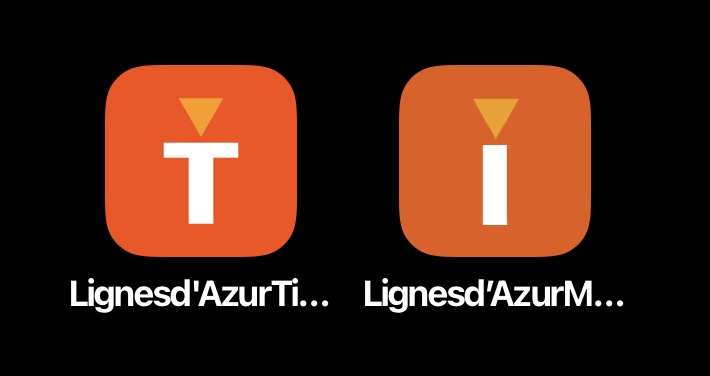
Google Transit
When it comes to researching and planning travel to all the amazing places you undoubtedly want to visit during your adventures in the French Riviera, trip-planning mobile helps are indispensable tools for figuring out the best way to get where you’re going. I like to use Google Transit, but Moovit is another popular app to consider.
One thing to keep in mind is that Google is not infallible and for various reasons doesn’t always provide accurate information. One reason is that if an agency is in the middle of implementing a schedule change (which can sometimes happen a few times a year), it can take a little time for Google to “learn” and display the new schedules in its search results. Temporary service disruptions (e.g. bus detours) can also throw off results, and finally, not every agency provides Google with its schedule data.
After I do research on Google, I sometimes head to the transit agency website to look at route maps and confirm schedule and fare information. If you don’t feel comfortable with French, your browser should have a translation feature, or you can check to see if they offer an English version, usually indicated with a British flag. (Note that even if they have English translation, some pages and/or PDFs may still show up in French.)
Tourist Bureaus
Never underestimate the value of local tourist information centers. They often have brochures (in English) about specific destinations and how to get to them via public transit. This is the kind of information you might not glean from a transit agency website, as they tend to be geared toward local customers, especially the smaller agencies in less touristy areas. When I was staying in Menton, for example, I went to the tourist bureau during my first week, and that’s how I learned there were cool hilltop villages nearby that I could get to using the local Zest bus.
Taking The Train

Let me start by saying that the TER PACA train will be your best friend in the South of France. They quickly connect all the main towns and cities of the French Riviera between Cannes and Ventimiglia, Italy. Hugging the coast and darting in and out of tunnels carved into the Riviera’s fabled cliffs, the train is also one of the most scenic ways to get around.
Used by locals and tourists alike, TER is a bit like commuter rail in the U.S. – think Long Island Railroad in New York or Metra in Chicago but with greater frequency and reach. Trains run every 15 to 30 minutes depending on the time of day.
These trains are not to be confused with the bright-red trams in Nice, which are operated by a separate agency, Lignes d’Azur. They have different fares and tickets, which I’ll explain later.
How to pay for a TER train ticket
While you can purchase train tickets from SNCF’s blue ticket kiosks at stations, I recommend you download and purchase your tickets via the SNCF Connect app. The ticket machines are clunky to use in my opinion (especially when you’re using them for the first time) and sometimes broken. The bigger issue, however, is that during busy travel periods the lines at the machines can be frustratingly long, and when there are lots of people who don’t know how to use them, you could end up missing your train! The app is much more convenient as you can buy your tickets ahead of time and go straight to your train.
NOTE: You cannot use your TER train ticket on SNCF trains such as TGV or OuiGo that are not part of the TERbregional rail network.
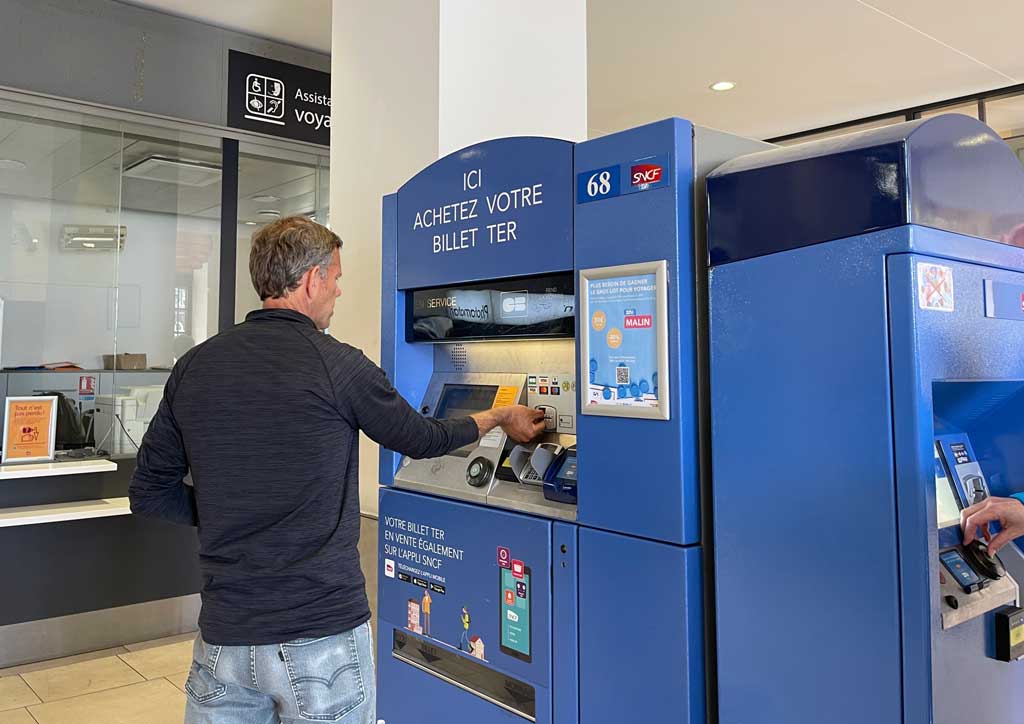
What about third-party ticket apps?
Many visitors use third-party ticket apps, like Trainline. These apps generally have more user friendly interfaces and are in English, which is why they are so popular. But they do charge a service fee on top of the regular fare, which is why I prefer to go through the SNCF Connect app for all my train travel within France.
The only time I used Trainline was when was going to Italy and needed to make multiple connections on different types of Italian rail services. Even then, I booked the very short French segment of my trip to Ventimiglia separately on the SNCF Connect app.
Unreserved service = more flexibility
TER train fares are based on the origin and destination of travel. Unlike SNCF’s long-distance trains, fares do not go up as you get closer to your travel date, so there’s no need to book trains far in advance.
It’s also helpful to note that when you buy a ticket, you are not reserving a specific seat – all TER trains have general boarding. During the busy summer months or around big events (e.g., the Monaco Grand Prix in May), some trains may be standing room only, but you’ll never encounter a “sold out” train.
Finally, you don’t have to travel on the same train that you booked. You can take any other TER train as long as it’s on the same day and with the same origin/destination stations. When I was doing a day trip from Menton to Monaco, for example, I would buy a round-trip ticket on the SNCF Connect app in the morning (while I had wifi in our apartment) and select a random return trip so I wouldn’t have to worry about getting another ticket later.
TIP: Be sure to have your ticket with you or on your phone to present to the controller when asked. While it may seem there’s often no one on board to check tickets, if you are caught without one (or even with the wrong type of ticket), the controller could make you pay not only the expected fare but also a steep fine. SNCF is serious about enforcing payment on trains so consider yourself warned!
Here is a sample of regular, one-way fares from Nice-Ville on the TER train, plus the approximate length of each trip. (Note these fares were effective at the time of this writing, so be sure to check for yourself as fares generally increase over time.)
- Villefranche-sur-Mer: €2,50, 5 minutes
- Monaco: €4,90, 20 minutes
- Menton: €6,40, 35 minutes
- Ventimiglia, Italy: €9,20, 50 minutes
- Antibes: €5,70, 25 minutes
- Cannes: €8.40, 40 minutes
- Grasse: €11,90, one hour and 10 minutes
Nice’s Trams and Buses
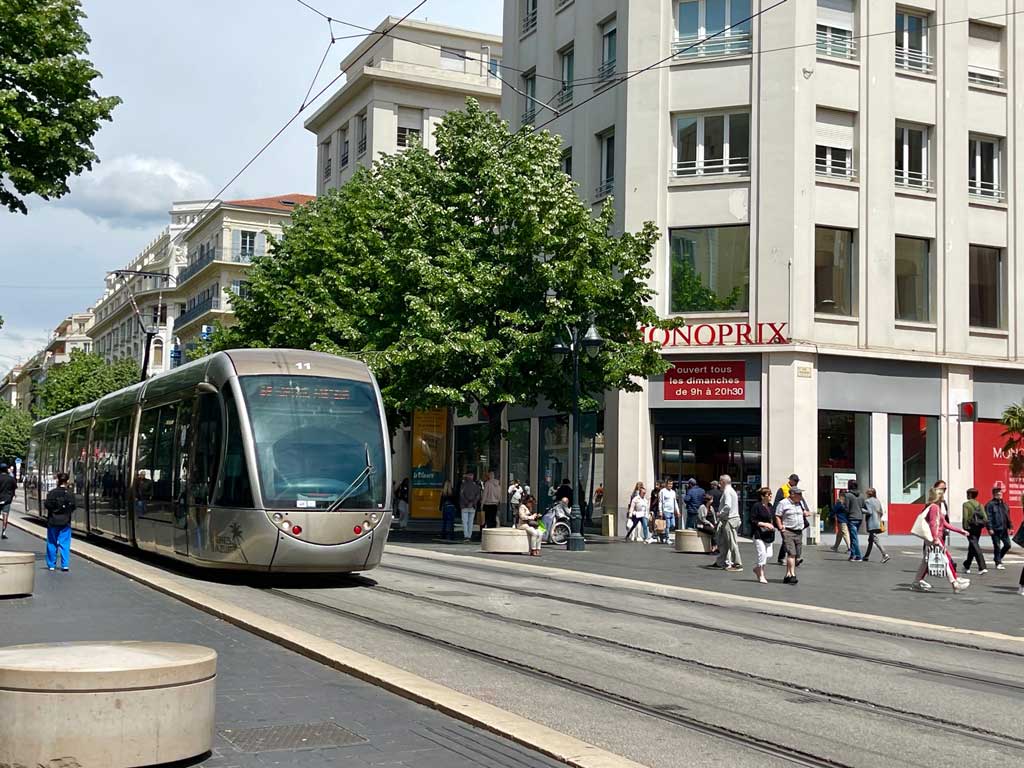
Not to be confused with SNCF TER, Lignes d’Azur is the public transportation system for the city of Nice. It consists of three tram lines and an extensive network of bus routes that operate throughout the city and into surrounding towns, including some of the harder-to-reach hill towns like Èze-Village. (You can read all about how to get to Èze-Village here.)
Most people first encounter Lignes d’Azur upon landing at Nice International Airport. Its sleek, bright-red trams provide service between the airport and the Grand Arénas stop adjacent to the Saint-Augustin SNCF rail station, as well as various destinations within the center of Nice. For reference, the Saint-Augustin Station is a five to 10-minute tram ride, while the center of Nice is about half an hour.
NOTE: The tram ride to the Saint-Augustin Station is FREE – there is no need to purchase a ticket!
Paying your fare on Lignes d’Azur
Lignes d’Azur has its own fare payment system that is separate from SNCF TER. You cannot purchase a Lignes d’Azur ticket from the SNCF Connect app or from an SNCF TER ticket machine, nor can you buy a TER train ticket from Lignes d’Azur. You will see ticket machines for both agencies at multi-modal stations, so make sure you’re using the right one. The TER train ticket machines are blue and have an SNCF logo.
Unless you are an Android phone user, you must purchase a plastic fare card (see picture below) called La Carte to pay your fare on board all Lignes d’Azur trams and buses. The one important exception is the tram between the airport and the Saint-Augustin rail station, which is free even though they don’t publicize it well.
La Carte is available at any Lignes d’Azur point of sale, including ticket machines at tram stops, as well as at Nice’s three train stations – Nice-Ville (the main train station in the city center), Saint-Augustin (by the airport), and Nice-Riquier.
You cannot buy La Carte at the airport; instead, Lignes d’Azur sells a special airport ticket for €10 – more on this later!
There is a refundable deposit fee of €2 to purchase La Carte initially. You can add value to your card at any of the ticket machines or by using the Lignes d’Azur Ticket app. I describe this process in another blog post, but in a nutshell you open the Ticket app, click “Top-up a card,” and then scan your physical card as prompted on the screen to purchase tickets. When you board a bus or tram, you tag La Carte on one of the on-board ticket validation machines where it says “Validez Ici.”
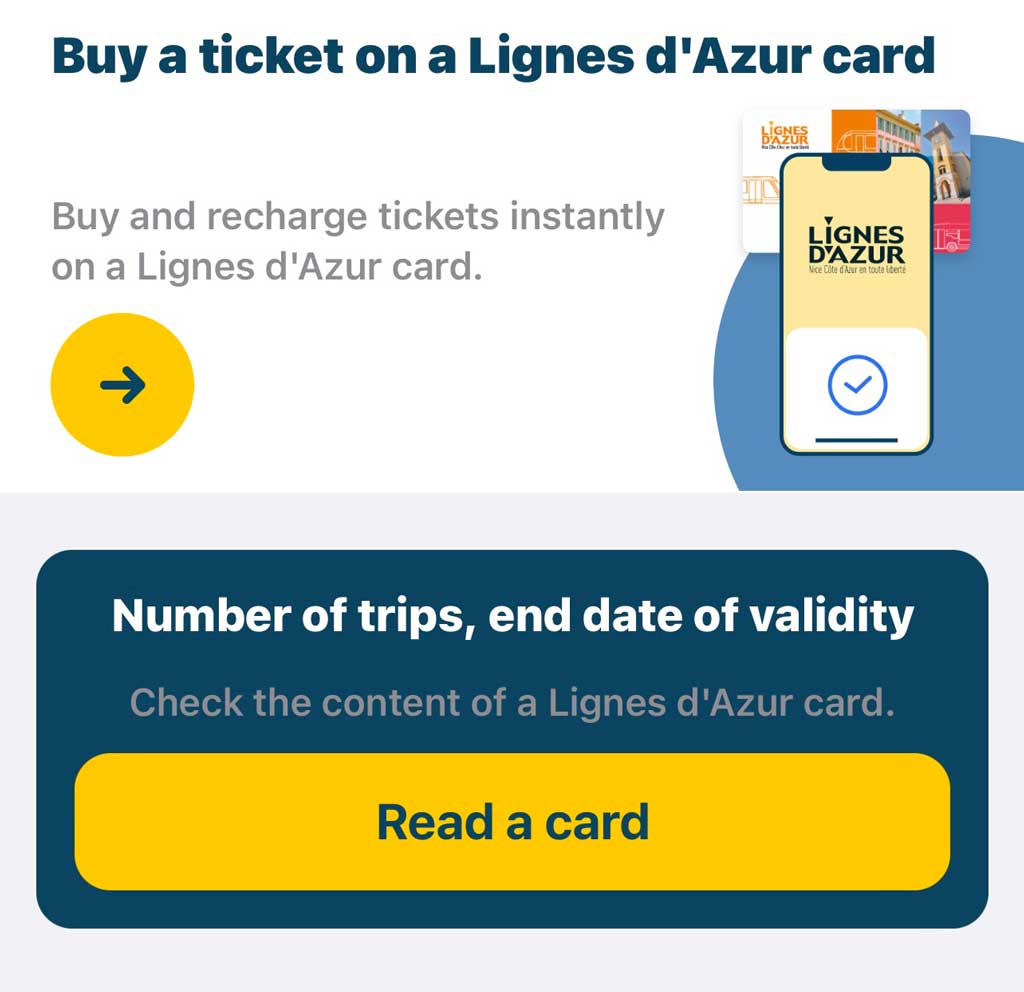
If you’re an Android user . . .
Lucky you! Android phone users do not need a physical Lignes d’Azur card. After downloading the Ticket app, you can purchase tickets and validate your fare on board the trams and buses with your phone directly by activating NFC (Near Field Communications). I am not sure when or if this technology will be available on iOS, but my guess is they are working on it.
Lignes d’Azur fares
At the time of this writing, the regular, the regular, one-way fare on Lignes d’Azur trams and buses was €1.70. Fare discounts kick in as you buy more trips (or voyages, as they’re called.) If you purchase one to 12 trips, the per-trip fare is €1.70. Purchasing between 13 and 25 trips, the per-trip fare drops to €1.50. Between 26 and 50 trips you pay €1.30, and 51 trips or more will cost just €1.
You can also load a 1-, 2- or 7-day pass onto La Carte. At the time of this writing, pass prices are as follows, but you should always doublecheck:
- 1-day pass: €7
- 2-day pass: €13
- 7-day pass: €20
The multi-day pass is only good on Lignes d’Azur trams and buses. You cannot use it on TER trains like you can with ZOU!’s Pass Sud Azur.
€10 airport ticket (Carte Aéro)
So, this is where things get weird. For some reason, Lignes d’Azur makes it impossible to purchase a regular-fare ticket at the airport . . . unless you’re an Android user or you already have a card, in which case you would simply use the Lignes d’Azur mobile Ticket app to load a regular fare as I described above.
Otherwise, you will have no choice but to purchase Lignes d’Azur’s “special” round-trip Airport Ticket, or Carte Aero, for €10. That’s right, you must pay €10 for a round-trip ticket even if you have no intention of returning to the airport – although if you are, remember to keep the ticket! You’re also technically overpaying by €6.60 since two trips should only cost €3.40 based on the regular one-way fare of €1.70.
Fortunately, there is a work around. From the airport terminal, you can ride the tram for free to the Grand Arénas stop at the Saint-Augustin rail station, get off, purchase La Carte and a regular-priced ticket from one of the Lignes d’Azur ticket kiosks, and hop on Tram Line 2 to continue into Nice. Voilá, you’ve beat the system!
Local and Regional Buses
In addition to the TER trains and Lignes d’Azur trams and buses, there are smaller, locally operated bus agencies, like Monaco Bus Company in – you guessed it – Monaco, and the Zest bus in Menton that I mentioned earlier.
These agencies operate service within their respective municipalities, and some go further afield. While staying in Menton, I sometimes took a Zest bus to surrounding hill towns, like Sainte-Agnès, Castillar, and Gorbio, that can’t be reached by train.
There is also a broader, regional bus network under the recognizable ZOU! brand, which includes the TER trains. These bus routes provide service between the region’s major cities and towns, as well as to and from the airport.
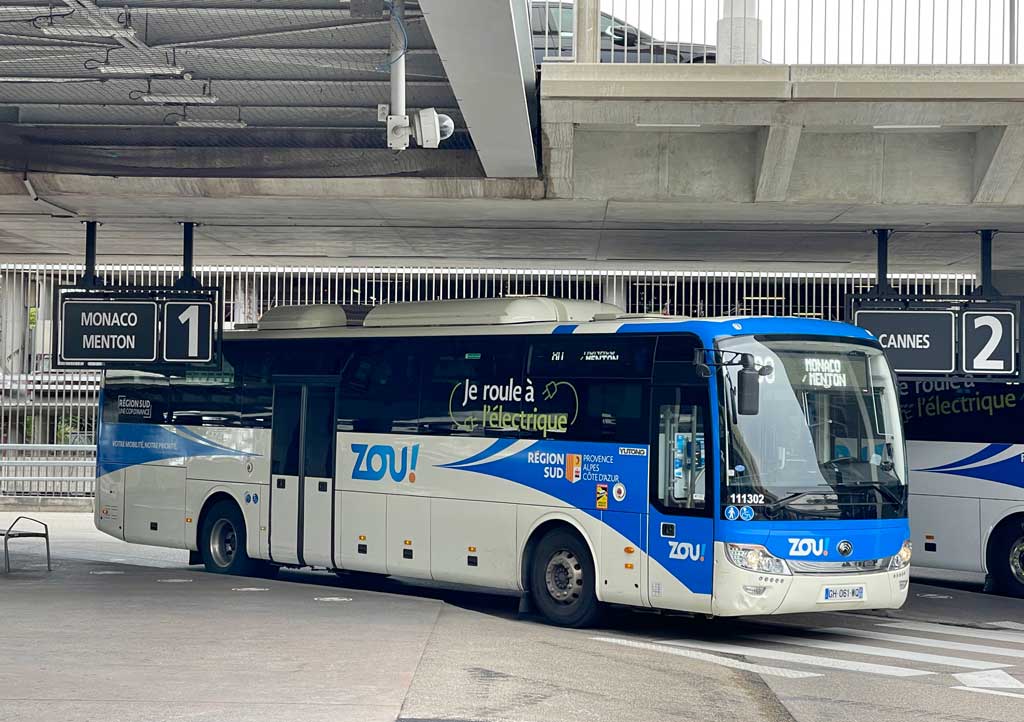
throughout the region.
Following are links for the various bus services you’re likely to encounter, as well as sample bus fares effective at the time of this writing*:
- Lignes d’Azur: €1.70 1-12 trips; €1.50 12-25 trips, €1.30 25-50 trips; and €1 more than 50 trips
- Monaco Bus Company: €1.50 with a daily cap of €5.50, weekly cap of €15 and monthly cap of €22
- Zest Bus: €2; 5 for day pass; €13 for 7-day pass; and €15 for 10-ride pass
- ZOU!: €2,10 (For Express buses, fares are based on distance.)
*Fares are subject to change, so be sure to check current fares ahead of time.
Note: Most bus stops don’t have ticket machines, so it’s important to know before you ride what the fare is and have the exact cash value on hand or the applicable ticket/fare payment card. If it’s a Lignes d’Azur bus, which doesn’t accept cash on board, be sure to have sufficient fare value on your card.
Getting to and from Nice Airport
Most airports in Europe are well connected to public transit, and Nice is no exception. The airport is served by Lignes d’Azur tram lines 2 and 3, which you can find outside each of the airport’s two terminals, along with several bus lines – mainly the regional ZOU! buses.
Going to Nice Center
If you are going straight from the airport to the center of Nice, there are two main ways to get there, both taking about 30 minutes:
Lignes d’Azur Tram Line 2
From either airport terminal, take Tram Line 2 in the Port Lympia direction. If you are staying in or near the port area of Nice, simply stay on this tram. Otherwise, most people get off at the Jean Médecin stop and walk to wherever they need to go or connect to Tram Line 1 for travel to various points of interest in the city.
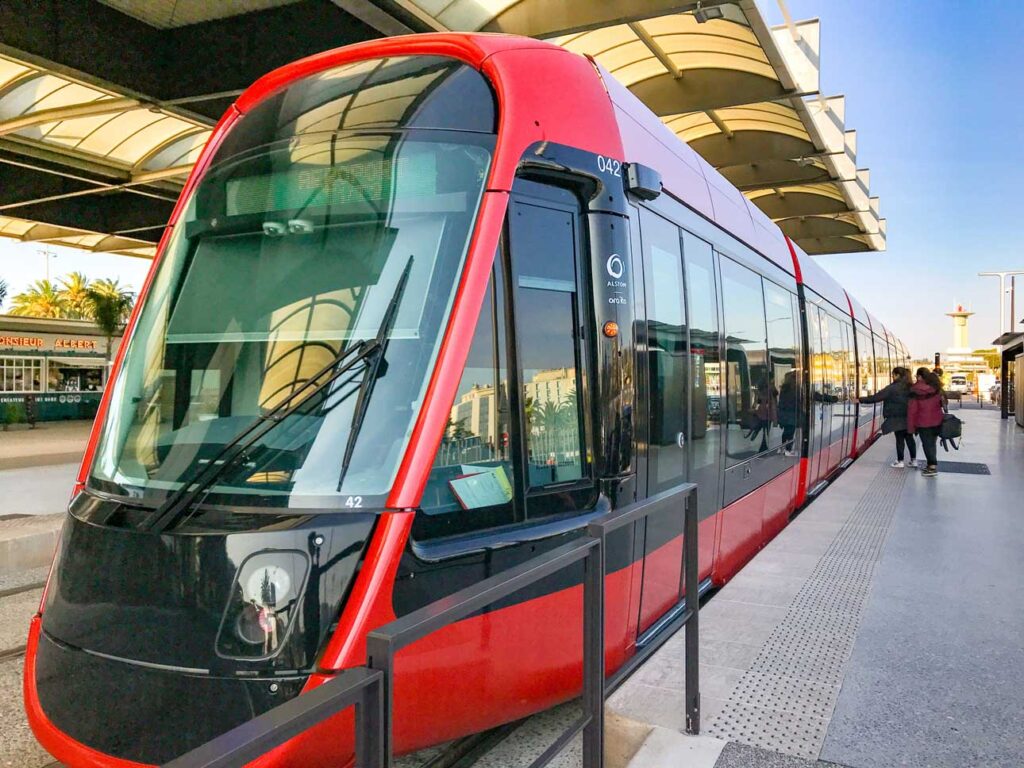
Going in the direction Hôpital Pasteur on Tram Line 1 takes you closer to the Promenade des Anglais. The tram stops at Place Masséna in the heart of Nice, as well as Opéra and Cathédrale, which are the two stops for Old Town Nice, often referred to as Vieux Nice or Vieille-Ville.
Or, if you’re going to Nice’s main train station for connections to SNCF’s high-speed or long-distance trains, you would take Tram Line 1 in the other direction, Henri Sappia, and go one stop to Gare Thiers, which is on the corner of Avenue Jean Médecin and Avenue Thiers and a short walk to the station entrance. You can use the same tram ticket you used on Tram Line 2 from the airport as long as your transfer to Tram Line 1 happens within 74 minutes.
NOTE: Nice’s main train station, Gare Nice-Ville is also called Gare Thiers and that is the name of the stop along the Tram Line 1 route.
Tram Line 1 also serves the city’s main bus station (Gare Routière) at the Vauban stop. This is where you might catch a bus to visit towns outside of Nice, such as Èze-Village. (You can read more about how to travel to Èze-Village here.)
Depending on where you’re staying, you may also want to stay on Tram Line 2 and take it to the Garibaldi stop, which is a lovely square on the northern edge of Vieux Nice and not far from Tram Line 1’s Opéra and Cathédrale stops.
NOTE: If you are taking Tram Line 2 to the airport from Nice, be aware that at the Grand Arénas stop/Saint-Augustin rail station, the line branches in two directions – Nice Airport and CADAM. When boarding the tram, be sure to get on the one marked Airport. The one marked CADAM will take you to the Administrative Centre.
Lignes d’Azur Bus 12
Lignes d’Azur’s bus 12 (toward Palais des Expositions) provides service between Terminal 1 (Aéroport/Promenade stop) and Nice. Stops in Nice include the Promenade des Anglais, Place Masséna, and Vieux Nice. Bus 12 runs daily every 10 to 25 minutes. It takes a little under half an hour to get to the Promenade.
What about Tram Line 3?
Tram Line 3 from the airport connects to the Saint-Isidore district of Nice and serves Allianz Riviera Stadium, which would be of interest to anyone attending a sporting event or concert. It runs approximately every 15 minutes on weekdays but does not stop at the airport when there are events going on.
Going to places other than Nice
If you are staying in one of the many other beautiful towns along the Côte d’Azur and going there directly from the airport, your best bet is to take Tram Line 2 or Tram Line 3 directly from the airport terminal to the nearby SNCF Saint-Augustin station, which as I mentioned is adjacent to the Lignes d’Azur’s Grand Arénas stop.
Remember, there is no charge for taking the tram to Grand Arénas/Saint-Augustin, and travel time between the two terminals and the rail station is five to ten minutes depending on which terminal you are at. Terminal 1 is closer, and it takes roughly five minutes by tram, while from Terminal 2 it’s about 10 minutes.
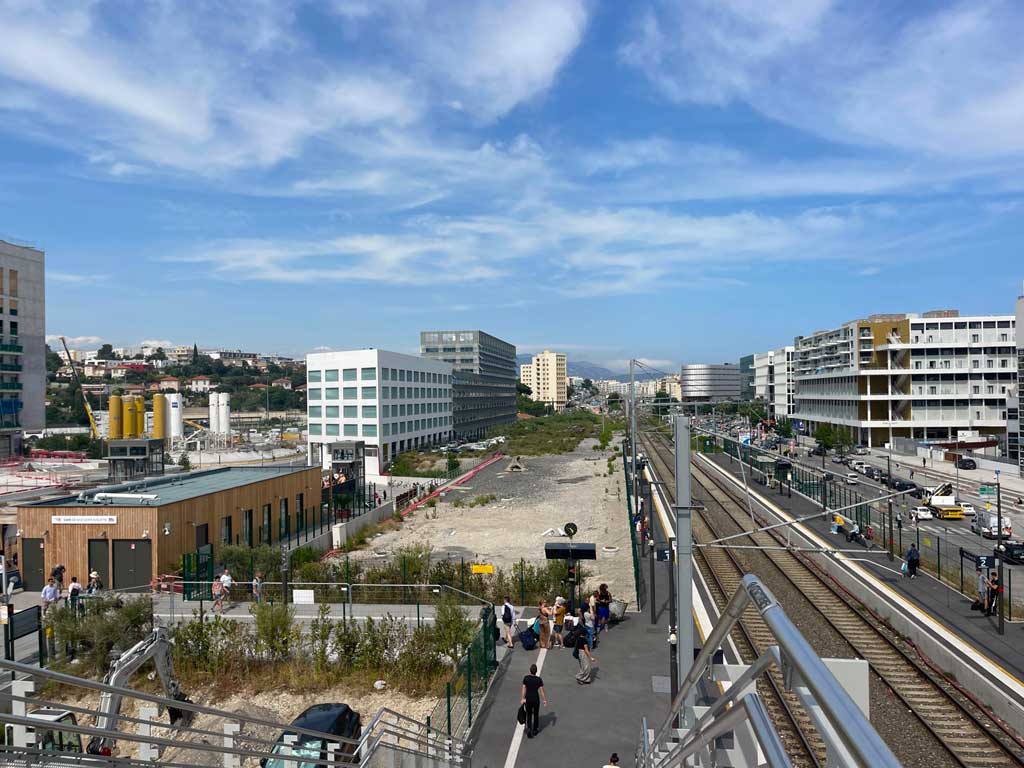
If you don’t have a lot of luggage, you could also walk between the airport and train station. From Terminal 1, the walk is about 12 minutes, but from Terminal 2, which is further away, the walk is closer to 20 minutes.
At the Saint-Augustin station you can catch trains to many wonderful destinations in the South of France like Villefranche-sur-Mer, Monaco, or Menton. For these towns east of Nice, you take the train toward Ventimiglia, Italy. (In French it’s Ventimille.) This is TER’s easternmost station and where you connect to the Italian rail system. For reference, the travel time between Nice-Ville and Ventimiglia is about 50 minutes. The train ride to Villefranche-sur-Mer takes less than 10 minutes.
If you’re headed west of Nice to places like Antibes, Juan-les-Pins, or Cannes, you take the train toward Grasse or Cannes. You can also travel as far west as Marseille with a connection. Travel time to Cannes is a little more than half an hour.
What About Discount Passes?
My short answer is “no.” Discount passes (e.g. a monthly pass) are most useful to locals who travel frequently between the same stations or stops. For most visitors – even those staying a while – it doesn’t make a lot of sense because generally you’re not traveling to the same place every time, and you might be using a variety of different modes.
Furthermore, transit fares are not that expensive, so you’re not going to be saving gobs of cash. And the money you might save isn’t worth the effort of trying to figure out your breakeven point.
The reality is, during your time in the South of France, you will mostly travel by train, and when you’re in a town or city, you’ll likely be doing a lot of walking. Even Nice, as big as it is, is quite walkable. (Two notable exceptions are the Matisse and Renoir museums for which you’ll probably want to take the bus.)
That said, if you like the idea of having a discount pass, here are a couple to consider. (Be sure to check out the websites I provide, as terms and conditions vary and can be confusing, which is why I generally recommend skipping passes altogether.)
Sud Azur Explore Pass
This is probably the most inclusive pass and the best deal out there.It offers unlimited access to TER trains, as well trams and buses in the region’s six departments and Monaco. There are three pass options:
- 3-day pass for €35
- 7-day pass for €50
- 14-day pass for €80
The Sud Azur Explore pass is only sold on the Lignes d’Azur La Carte or on a personal ZOU! card. I could not find a way to buy this pass on the SNCF Connect mobile app. For more information, including where you can buy the pass, click here.
TER Day Pass
This pass offers unlimited travel for one day on TER trains (no buses or trams) within one or two departments. (the Alpes-Maritime is considered one department.) Fare options are as follows:
- €20 for one department
- €35 for two departments
- €5 for each additional travelers up to eight
You can purchase a TER Day Pass at rail ticket counters and regional (ZOU!) ticket kiosks at stations, and on the SNCF/TER/ZOU! website. Supposedly, you can purchase this pass from the SNCF Connect website and app; however, I could not find it there.

